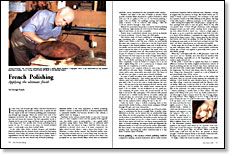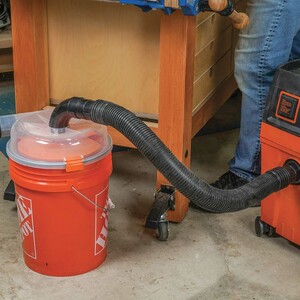
Synopsis: George Frank learned French polishing in 1922 and shares touching memories of his instruction. In this article, he conveys what he calls the true French way of French polishing, a glossy shellac finish that is not easy to achieve. It’s an extremely durable finish, but it has its limits. Frank mixes his own so he has control over the quality of the ingredients, and he shares his tools and methods of mixing the shellac. He explains the differences between the Italian, English, and American schools of French polishing and the true French way, and how to handle things like the underside and edges of a piece and moldings and carvings.
It was 1922, over 60 years ago, when I was first introduced to French polishing. My teacher couldn’t hear or speak, but she was expert in the arts of French polishing and communicating through sign language. When she twirled both ends of her imaginary moustache she was talking about the boss, twirling just one end meant the foreman. She had unprintable words to chastise me for my errors; hugs and kisses were my reward when I was doing well. Two months later, French polishing had no secrets for me. If I could join the areas I’ve French polished since, I could easily cover three football fields.
In the olden days, before modern lacquers and varnishes, French polishing was the ultimate finish, reserved for fine luxury furniture. Even today, the beauty of this glossy shellac finish is unparalleled, but the skill is not an easy one to acquire. Here, I will convey to you the true French way of French polishing. Materials—Shellac is the main ingredient in French polishing. Shellac’s solvent is denatured alcohol. A French-polished finish is extremely durable, but because alcohol is the solvent, a spilled drink can damage it.
Hardware stores sell pre-mixed shellac in cans, but I mix my own so I have complete control over the quality of the ingredients, Dry shellac comes in many grades. I use a grade called superfine orange flakes. These flakes have an unlimited shelf life while dry, and almost as long a shelf life when they are dissolved in alcohol (don’t store it in metal containers). On light colored woods, where I want a water-clear finish, I use bleached, or white shellac instead. Dry bleached shellac must be kept very cold and even so, it won’t keep long. For this reason, I buy white shellac already mixed, and not more than I can promptly use up. Super blonde flakes, which have an unlimited shelf life, can be substituted for the perishable white shellac.
Shellac’s “cut” refers to the ratio of shellac to alcohol. Three pounds of shellac flakes dissolved in a gallon of alcohol is called 3-lb.-cut, 5 lb. in a gallon is 5-lb.-cut, etc. For French polishing, I make lb.-cut shellac. For moldings, carvings and turnings I make a heavier, lb.-cut solution. After mixing, I filter the lb.-cut solution through a clean cloth.
From Fine Woodworking #58
For the full article, download the PDF below:
Fine Woodworking Recommended Products

Dustopper Pro

Tite-Mark Marking Gauge

Veritas Standard Wheel Marking Gauge





















Log in or create an account to post a comment.
Sign up Log in